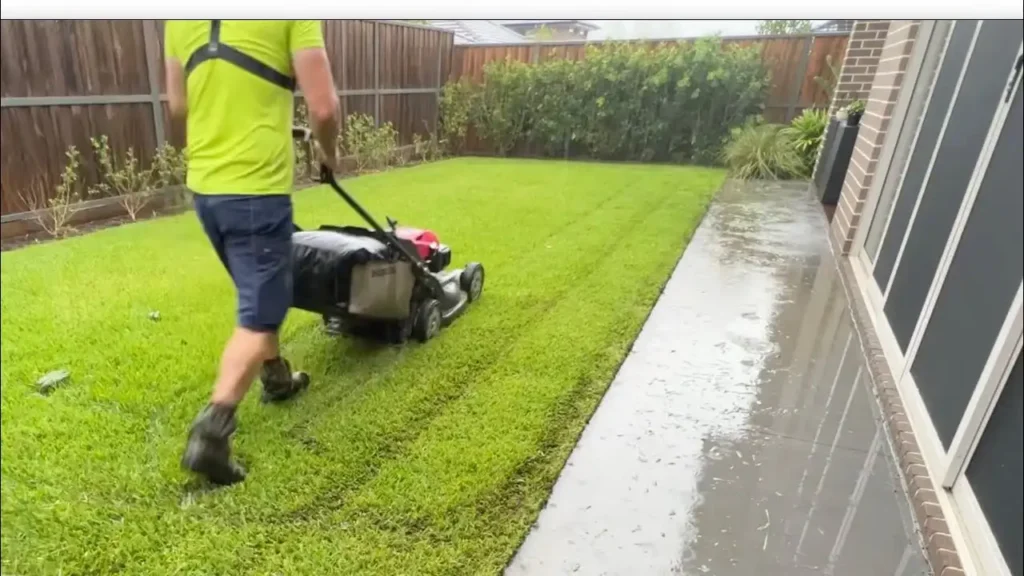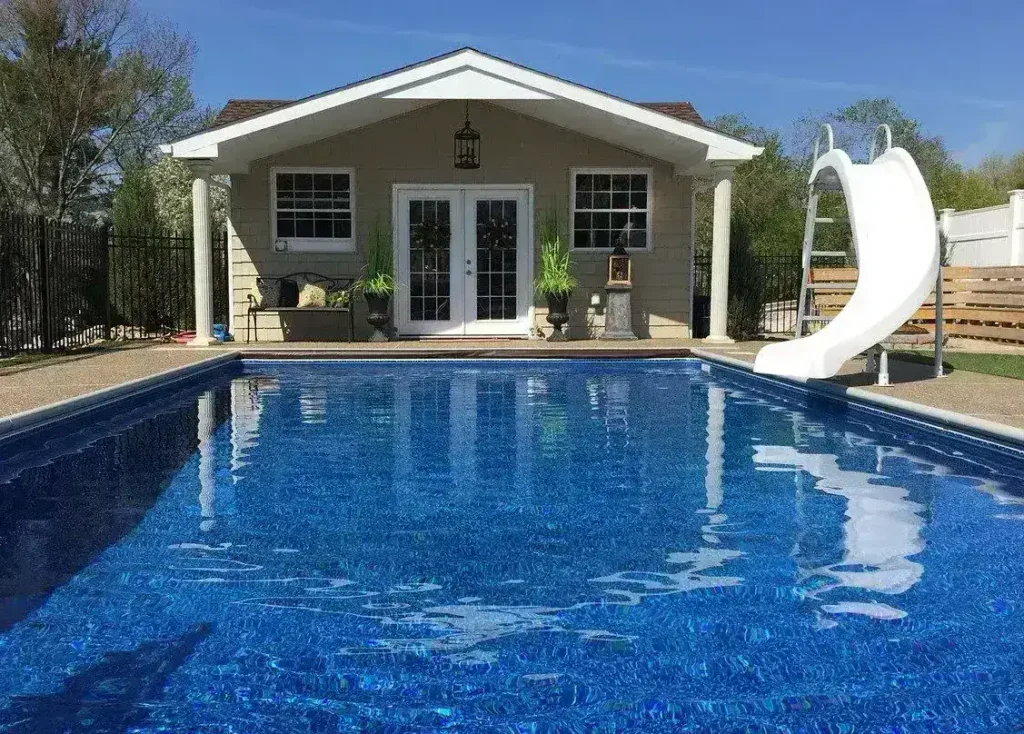Mowing damp grass means cutting it wet from rain or dew. Wet grass is challenging to cut to perfection and could harm your lawn and mower. If you understand better why wet grass should be avoided, you will give your yard much better care.
Why should mowing not be done after a rain? Mowing in wet conditions poses risks to the turf, damages turf quality, and can even cause damage to the mower itself. Read on to learn why waiting for the grass to dry out is better!
Wet mowing weakens and unevenly damages the lawn, clogs the mower, and reduces its working lifespan. Therefore, mowing is much better when the grass is dry and healthy, which is essential for results.
Can you mow wet grass?

Mowing wet grass may not be the best choice. Wet grass can become soft and, depending on the sharpness of the mower blade, tend to tear rather than be cut evenly, leaving the lawn looking incomplete. Cutting wet grass also strains the mower and encourages clumping or even damage. Thus, it is recommended that you wait until everything dries up for the best results.
Why You Shouldn’t Mow Wet Grass
Regular mowing is key to keeping the yard clean and healthy. However, mowing in wet conditions can cause more harm than good. Many people are unaware of the hazards of mowing damp grass, but learning not to do it could save them time, effort, and money. Here are six essential reasons not to mow wet grass.
1. Health of Your Lawn
The health of your lawn should always be a top priority, and mowing wet grass will surely hurt it. When wet, grass is more vulnerable to diseases such as fungal infections. Wet conditions enable harmful bacteria and fungi to spread quickly as the mower blades cut through the damp grass and scatter clippings all over your yard.
Mowing wet grass can also damage the mower blades. Instead of cleanly cutting grass, the unmoistened turf will be torn unevenly from the surface by the mower, leaving jagged edges with a more difficult healing process for the plant. These jagged terrains exposed by the injury make your lawn more favorable to pests and diseases.
Pro tip: Always wait until your grass is dry before mowing to ensure a clean cut and help reduce the spread of diseases.
2. Clogging and Clumping
One of the most annoying issues with mowing wet grass is the clumping that clogs the mower. The damp grass sticks together into lumps that block the mower deck and blades. This clumping makes mowing inefficient, as you cannot mow every hour to clean the clogging out.
The clumps create more problems for both the mower and the lawn. Left on the ground, clumps of wet grass have the potential to suffocate healthy grass beneath them, blocking sunlight and airflow. This can lead to brown patches or even dead spots in your yard.
Pro Tip: If you mow wet grass, immediately rake up any clumps to avoid damaging your lawn.
3. Danger of Slipping
Your safety must always take precedence whenever you do something in your yard. Slipping and falling are further hazards while mowing wet grass if the mowing is done on a slope or uneven terrain. Damp grass is treacherous to walk on because it can throw your balance while mowing with a huge mower pulling backward or with a push mower.
The risk to one’s safety is not the only consequence of slippery conditions; one could also lose control of the mower. Accidents or damaging nearby helpless plants, fences, or structures in your yard can be the result.
Pro Tip: Wait until the ground dries out for a significantly lower risk of accidents and planned safe equipment handling.
4. Wheel Ruts
Wet soil becomes soft and unstable. You create deep wheel ruts in the yard if you run a heavy lawn mower over waterlogged ground. These ruts spoil the yard’s otherwise smooth appearance and cause drainage problems in the long term.
It then compacts the soil along the way, hindering water and nutrients from reaching the roots of your grass. Consequently, over time, this process significantly undermines the health of your lawn: it will eventually become difficult for new grass to grow uniformly.
Pro Tip: Wait 24-48 hours after rain before mowing to avoid creating wheel ruts.
5. Stained Clothes
Some blades of grass seem determined to cling to every possible piece of fabric or attachment: shoes, pants, gloves, or even a deck. Wet grass releases much more pigment that can stain fabric than dry clippings. These stains can be challenging to remove from the clothing and require extra cleaning.
This is inconvenient after mowing and tedious to clean the mower. Wet clippings cling obstinately to the underside of the mower deck, requiring extra scrubbing or even entire disassembly to remove thoroughly.
Pro tip: Wait for the grass to dry before mowing. This will save time and hassle, and cleaning will be much easier!
6: Damage to Your Lawn
Over time, each grass undergoes damage from many causes. Short or low-cutting mowing the grass, which becomes weak and dries out; over. Overwatering will also. When water stays too long in the soil, it causes root rot in grass. On the other hand, when there is not enough water, the poor grass will turn.
Foot traffic is another reason lawns are damaged. People walking on the grass too often can compress the soil and make it hard for grass roots to grow. Then there are problems related to foes: insects and diseases that can cause damage. They eat up the grass or cause ill effects on it. Overusing chemicals, particularly fertilizers or pesticides, can also hurt the grass. Therefore, keeping up with lawn maintenance—mowing, watering at the correct times, and pest control—is vital.
Pro tip: Annual lawn aeration can relieve soil compaction, allowing water, nutrients, and air to flow easily to the roots.
Don’t mow during the hottest part of the day.
Lawn mowing during extremely hot hours, usually between 10 AM and 4 PM, is not advisable. Grass would experience significant stress and dry out faster if mowed at such hours. And to top it all, hot sun rays would cause your grass blades to lose their strength, making mowing more damaging. Early morning or late afternoon would be the perfect time to mow when the temperature is cooler, giving the grass a better chance of recovery post-mow without undue influence from heat. Besides, you don’t want to overheat yourself!
Final Thoughts
Mowing wet grass poses six important reasons against mowing. First, damp grass can harbor diseases like fungi and bacteria that may harm the lawn—second, mowing when the grass is wet, creating uneven cuts, making healing difficult for grass. Thirdly, damp grass clippings tend to clump, clogging the mower and making it impossible to mow. Fourthly, mowing wet soil leads to ground compaction, which inhibits air and nutrient flow to the roots.
Fifth, mowable grass easily tears under stress, causing lawn damage. Lastly, mowing wet grass will exert extra stress on your lawn mower and wear it down. Waiting for dry conditions is best for your lawn and mower’s well-being.
FAQS
Q1. Why is cutting wet grass considered flawed?
When cutting wet grass, blades are torn instead of cleanly cut, resulting in damaged lawns exposed to diseases that can weaken the grass. Besides, wet clippings obstruct the mowers and inhibit growth.
Q2. Does cutting wet grass cause fungus?
Yes, wet mowing increases the onset of fungal disease by spreading water and pathogens across the lawn, providing conditions necessary for infections to establish.
Q3. How long should I wait to cut the grass after rain?
After rain, it is better to wait 24 hours to dry the grass before mowing correctly. This will reduce the chances of damaging the lawn and make a healthy cut.
Q4. When not to mow the lawn?
One should avoid mowing during the hottest part of the day or if the grass is wet due to rain or dew. Mowing under such conditions can distress the grass and impede its recovery.
Q5. What is the best time to cut the grass?
The best time to mow your lawn is in the late afternoon or early evening when temperatures are cooler. This allows for better cutting conditions and less stressed grass.


